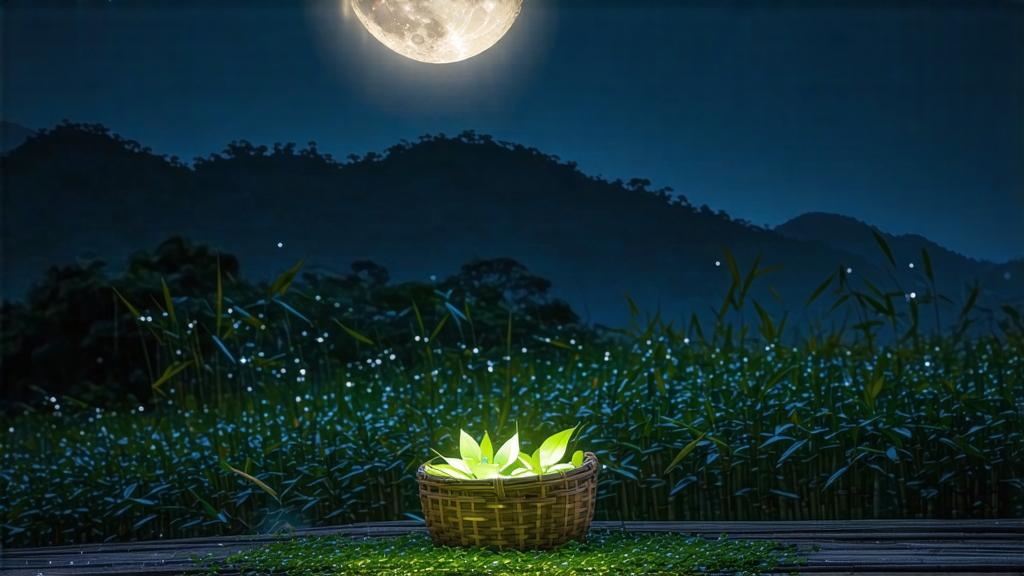
Tucked high on the forested ridges of Yunnan’s Simao and Lincang prefectures, a tea that refuses to see the sun is quietly transforming the global perception of Chinese white tea. International drinkers know Bai Hao Yin Zhen (Silver Needle) and Bai Mu Dan (White Peony), yet few have tasted Yue Guang Bai—literally “Moonlight White”—a cultivar whose entire life cycle is choreographed around darkness and soft lunar radiance. Its leaves, one side silvery-white, the other charcoal-black, look like slices of moonlit cloud torn from the night sky. In the cup it brews the color of antique champagne, smells of midnight orchards, and finishes with the cool sweetness of alpine stone-fruit. To understand Yue Guang Bai is to step into a nocturnal ritual that predates written records, where tea makers become astronomers, timing each movement by the wax and wane of the moon.
Historical origins remain deliberately veiled. Local Dai, Hani and Lahu communities tell an overlapping legend: during the Ming dynasty a caravan of compressed Pu-erh bricks was caught in a storm; bales were abandoned in a moon-washed clearing. Weeks later passing traders noticed the leaves had bleached on one side, oxidized on the other, and exuded an unprecedented honeyed fragrance. Whether myth or memory, the story encodes two facts modern chemists confirm: absence of direct solar radiation alters enzymatic pathways, and the large-leaf Assamica varietal native to Yunnan possesses higher polyphenol oxidase activity than the small-leaf Fujian bushes used for orthodox white teas. In short, Yunnan’s landrace tea trees are genetically primed for this lunar choreography.
Botanically the tea belongs to Camellia sinensis var. assamica, but locals subdivide it into three micro-cultivars: “Da Yue Guang” (large-leaf moonlight), “Xiao Yue Guang” (small-leaf moonlight) and “Ye Sheng Yue Guang” (wild moonlight). Each thrives between 1,400 and 1,900 m where diurnal temperature swings can exceed 15 °C. The wild strain, harvested only in early spring from trees exceeding 300 years, produces fewer than 300 kg annually; most never leaves the province, snapped up by Kunming collectors who age it like raw Pu-erh.
The craft protocol begins not in the field but in the sky. Pickers consult a lunar calendar that marks “black moon” nights—those without visible moonlight—as unsuitable. Ideal plucking occurs on the 12th to 16th nights of the lunar month when the gibbous or full moon rides highest, its light richest in 400–500 nm wavelengths. Experienced pickers harvest only the terminal bud and first two leaves, never using fingernails which bruise cells; instead they roll the shoot between thumb and forefinger until it audibly snaps at the abscission layer. Baskets are woven from fragrant bamboo to discourage insect attack, and every 30 minutes the leaves are gently turned so moonlight kisses each surface evenly.
With the first rooster cry—still hours before dawn—the caravan of baskets moves to the “moon room”, a ventilated loft whose windows are shuttered at sunrise. Here the magic of yin drying unfolds. Leaves are laid on raised bamboo trays in single layers no thicker than two millimeters. For the next 48 to 72 hours the room remains in twilight; electric lights are forbidden, and even candles are screened through red paper to filter out blue spectra that might trigger photosynthetic rebound. The goal is partial enzymatic oxidation—around 15 %—halfway between green and black tea. Because no direct heat is applied, moisture evaporates slowly, carrying with it grassy volatiles and leaving behind lactones responsible for peach and honey notes. Every six hours the tea master tests leaf suppleness; when the central vein becomes brittle yet the lamina remains pliable, the batch is ready for the final “embrace of darkness”. Trays are stacked, covered with hemp cloth, and left to rest another night so internal moisture equalizes. By dawn the two-tone coloration is locked in: the downy underside stays lunar silver while the upper surface oxidizes to obsidian.
Unlike Fujian white teas that demand low-temperature, short infusions, Yue Guang Bai is forgiving yet paradoxical: it rewards patience but punishes heaviness. The international taster should begin with